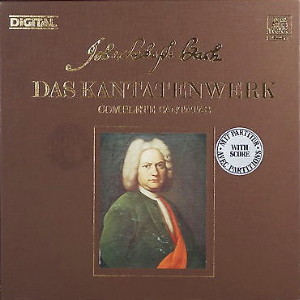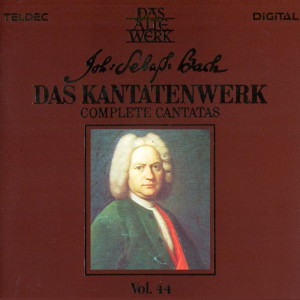 |
2 LP -
244 193-1 EX - (p) 1989
|

|
| 1 CD -
244 193-2 ZK - (p) 1989 |
|
Johann
Sebastian Bach (1685-1750)
|
|
|
|
|
|
|
|
| Das Kantatenwerk - Vol. 44 |
|
|
|
|
|
|
|
| Kantate "Nun danket
alle Gott", BWV 192 |
|
12' 23" |
A |
Solo: Sopran, Baß - Chor
|
|
|
|
| Flauto traberso I, II; Oboe I,
II; Violino I, II, Viola; Continuo
(Violoncello, Fagotto, Violone, Organo) |
|
|
|
| - Versus 1 (Chorus) "Nun
danket alle Gott" |
5' 29" |
|
|
| - Versus 2 (Duett) ( Soprano,
Basso) "Der ewig reiche Gott" |
3' 39" |
|
|
| - Versus 3 (Chor) "Lob, Ehr
und Preis sei Gott" |
3' 04" |
|
|
|
|
|
|
Kantate "Dem Gerechten muß
das Licht immer wieder aufgehen", BWV 195
|
|
18' 52" |
B |
| Solo: Sopran, Alt, Tenor, Baß -
Chor |
|
|
|
| Tromba I, II, III; Corno I, II;
Flauto traverso I, II; Oboe I, II; Oboe
d'amore I, II; Timpani; Violino I, II,
Viola; Continuo (Violoncello, Violone,
Cembalo) |
|
|
|
Vor
der Trauung
|
|
|
|
| - Chor "Dem Gerechten muß
das Licht" |
5' 24" |
|
|
| - Recitativo (Basso) "Dem
Freudenlicht gerechter Frommen" |
1' 19" |
|
|
| - Aria (Basso) "Rühmet
Gottes Güt und Treu!" |
4' 20" |
|
|
| - Recitativo (Soprano) "Wohlan,
so knüpfet denn ein Band" |
1' 15" |
|
|
| - Chor "Wir kommen deine
Heiligkeit" |
5' 51" |
|
|
| Nach der Trauung |
|
|
|
| - Choral "Nun danket all'
und bringet Ehr" |
0' 43" |
|
|
|
|
|
|
| Kantate "Höchsterwünschtes
Freudenfest", BWV 194 |
|
39' 13" |
|
| Solo: Sopran, Tenor, Baß - Chor |
|
|
|
| Oboe I, II, III; Violino I, II,
Viola; Continuo (Violoncello, Fagotto,
Violone, Organo) |
|
|
|
| Prima Parte |
|
|
|
| - Chor "Höchsterwünschtes
Freudenfest" |
5' 03" |
|
C1 |
| - Recitativo (Basso) "Unendlich
großer Gott" |
1' 09" |
|
C2 |
| - Aria (Basso) "Was des
Höchsten Glanz erfüllt" |
4' 47" |
|
C3 |
| - Recitativo (Soprano) "Wie
könnste dir, du höchstes Angesicht" |
1 23" |
|
C4 |
| - Aria (Soprano) "Hilf,
Gott, daß es uns gelingt" |
6' 03" |
|
C5 |
| - Choral "Heilger Geist in's
Himmels Throne" |
2' 09" |
|
C6 |
| Seconda Parte |
|
|
|
| - Recitativo (Tenore) "Ihr
Heiligen, erfreuet euch" |
1' 06" |
|
D1 |
| - Aria (Tenore) "Des
Hòchsten Gegenwart allein" |
3' 47" |
|
D2 |
| - Recitativo (Soprano, Basso) "Kann
wohl ein Mensch" |
2' 09" |
|
D3 |
| - Aria (Duett) (Soprano, Basso)
"O wie wohl ist uns geschehn" |
9' 23" |
|
D4 |
| - Recitativo (Basso) "Wohlan
demnach, du heilige Gemeine" |
0' 46" |
|
D5 |
| - Choral "Sprich ja zu
meinem Taten" |
1' 18" |
|
D6 |
|
|
|
|
Kantaten 192 -
194
|
Kantate 195
|
|
|
|
|
Helmut
Wittek (Tölzer Knabenchores), Sopran (192)
|
Jan
Patrick o'Farell, Sopran |
|
| Hans
Stricker (Tölzer
Knabenchores), Sopran (194) |
René Jacobs,
Alt |
|
| Stefan
Gienger (Tölzer
Knabenchores), Sopran (194) |
John Elwes, Tenor |
|
Kurt Equiluz,
Tenor (194)
|
Harry van der
Kamp, Baß |
|
| Thomas Hampson,
Baß |
|
|
|
Knabenchor
Hannover |
|
| Tölzer
Knabenchor |
(Heinz
Hennig, Leitung) |
|
| (Gerhard
Schmidt-Gaden, Leitung) |
Collegium
Vocale |
|
|
(Philippe
Herreweghe, Leitung) |
|
| CONCENTUS MUSICUS
WIEN |
|
|
| -
Robert Wolf, Flauto traverso |
LEONHARDT-CONSORT |
|
| -
Silvie Lacroix, Flauto traverso |
-
Friedemann Immer, Trompete, Horn
|
|
| -
David Reichenberg, Oboe |
-
Klaus Osterloh, Trompete, Horn
|
|
-
Hans Peter Westermann, Oboe (194)
|
-
François Petit-Laurent, Trompete |
|
-
Marie Wolf, Oboe
|
-
Ricardo Kanji, Flöte |
|
| -
Alice Harnoncourt, Violine |
-
Marten Root, Flöte |
|
| -
Erich Höbarth, Violine |
- Ku Ebbinge,
Oboe, Oboe d'amore
|
|
| -
Andrea Bischof, Violine |
-
Michel Henry, Oboe, Oboe d'amore
|
|
| -
Karl Höffinger, Violine |
- Michael de Roo,
Pauken |
|
| -
Anita Mitterer, Violine |
-
Alda Stuurop, Violine |
|
-
Peter Schoberwalter, Violine
|
-
Marinette Troost, Violine |
|
| -
Helmut Mitter, Violine |
-
Antoinette van den Hombergh,
Violine |
|
| -
Walter Pfeiffer, Violine |
-
Lucy van Dael, Violine |
|
| -
Kurt Theiner, Viola |
-
Marie Leonhardt, Violine |
|
-
Josef de Sordi, Viola
|
-
Ruth Hesseling, Viola |
|
| -
Herwig Tachezi, Violoncello |
-
Staas Swierstra, Viola |
|
| -
Milan Turković, Fagott |
-
Wouter Möller, Violoncello |
|
| -
Eduard Hruza, Violone |
-
Richte van der Meer, Violoncello |
|
| -
Herbert Tachezi, Orgel |
-
Anthony Woodrow, Violone |
|
|
-
Bob van Asperen, Orgel |
|
| Nikolaus
Harnoncourt, Gesamtleitung |
|
|
|
Gustav
Leonhardt, Gesamtleitung |
|
|
Luogo e data
di registrazione
|
Casino Zögernitz, Vienna
(Austria) - gennaio/marzo 1987 (BWV 192,
194)
Lutherse Kerk, Harlem (Olanda) - gennaio
1988 (BWV 195) |
|
Registrazione
live / studio
|
| studio |
Producer / Engineer
|
Wolfgang Mohr / Helmut Muhle
(192, 194) / Friedemann Engelbrecht
(195) / Michael Brammann
|
Prima Edizione
CD
|
Teldec "Das Alte Werk" - 244
193-2 ZK - (1 cd) - 70' 41" - (p) 1989 -
DDD
|
Prima
Edizione LP
|
Teldec "Das Alte Werk" - 244
193-1 EX - (2 lp) - 31' 20" + 39' 21" -
(p) 1989 - Digital
|
|
|
Introduction
|
It has
not been possible to
establish for
what occasion Bach
composed the cantata Nun
danket alle
Gott (BWV 192)
presumable
in the autumn
of
1730. The short work
was probably written
to add musical
splendour to a
marriage ceremony
or likewise embellish
the celebration of
Reformation Day. For
the text, Bach had recourse
to three verses ot the
hymn of
the same name by
Martin Rinckart
(1636). But Bach’s
mastery of his art is
evident in his
treatment of the three
stanzas of Rinckart’s
text, which are
absolutely identical
in terms of form.
The fourpart choir,
whose lost tenor part
can easily be
reconstructed from the
context, can be heard
in the two outer
movements with their
respectively
contrasting treatment.
In verse 1, Bach
combines contrapuntal
writing with the
concertante principle
and places alongside
the choral writing
evolved from
the chorale melody a
thernatically
independent
instrumental section,
whose individual
groups of
instruments (two
flutes, two oboes,
strings) even engage
in concertante
dialogue amongst
themselves. Verse 3,
on the other hand,
takes its character
from the dancelike
triple rhythm of
the gigue;
here, polyphonic vocal
writing and the
orchestral ritornello
are based on the
chorale melody, which
is allotted to the
soprano in long
note-values. The
harmonically cornplex,
two-part
second verse with its
measured, dance-like
air
clearly periodic
structure, orchestral
ritornelli, which are
once again
thematically
independent, and
chorale melody
presented by the
soprano and bass
soloists, torms an
effectively
contrasting, calm
central section.
----------
On
November 2, 1723, the
“newly-built organ in
the church at Störmthal”
was handed over to the
church authorities and
examined by the same,
and ”the following
cantata was pertormed
at the public service
for the inauguration
of the said organ,
played by Johann
Sebastian Bach..." -
thus the original
edition of
the cantata Höchsterwünschtes
Freudenfest (BWV
194). As with
many other works,
at least one secular
predecessor in Cantata
form was reworked -
or, to use the correct
term, parodied -
by Bach in this
large-scale, two-part
composition.
The work in question
is a gratulatory
cantata written before
1723 in Cöthen
for the royal house of
Cöthen-Anhalt
(BWV 194a), the text
of which has been
lost. Alfred Dürr
suggests that it is to
this work that we owe
the unusual concept of
applying the form and
expression of the
French overture, which
was extremely popular
in the first half of
the eighteenth
century, to the vocal
genre. Thus all the
arias are written in
dance character: No. 3
as a pastorale, No. 5
as a gavotte, No. 8 as
a gigue and No. 10 as
a minuet. The
anonymous author of
the text made use of a
hymnic tone
appropriate to the
ceremonial character
of the organ's
consecration. As a
theme in its own
right, based on two
different biblical
passages, it revolves
around the concept of
the right way to pay
homage to God,
demanding praise,
thanks and joy (Nos.1
&
7), an offering from
our lips ("Lippen
Opfer,” No, 2), i.e.
we should offer "songs
as gifts in adoration"
(No. 4) - an idea that
is also frequently
found in wedding
cantatas and cantatas
celebrating the
election of the new
city council
("Ratswechsel"). Both
of the two parts, each
of which consists of
six numbers and ends
with a chorale. No. 6
is based on two
stanzas of lohann
Heermann’s "Treuer
Gott, ich muß
dir klagen"
(True God, I
must pour out my
troubles unto you),
while No. 12 is based
on two stanzas of the
well-known
Paul Gerhardt hymn
"Wach auf, mein Herz,
und singe" (Awake, my
heart, and sing). Bach
initiated several
further performances
of the cantata after
1723, with a number of
alterations being made
on each occasion; and
the work was even
performed in Halle
after Bach’s death,
conducted by the
composers eldest son
Wilhelm Friedemann
Bach.
----------
The
wedding cantata Dem
Gerechten muß das
Licht immer wieder
aufgehn (BWV 195)
exists in three
different versions,
composed at different
times.
Originally composed
circa 1727 for "4
\/oci / 3 Trombe /
Tamburi / 2 Hautbois e
/
Flauti / 2
Violini / Viola
/ e / Continuo," it
was revised for a
repeat performance circa
1742. A further
performance took place
at some time between
August 1748 and
October 1749. For this
occasion, Bach cut
movements 6-8, and
added in his own
handwriting and "in
the ponderous style of
his old age" (H. J.
Schulze) as a new
sixth movement the two
stanzas of the Paul
Gerhardt chorale "Nun
danket all und bringet
Ehr" (1647) to the
score, set to the
melody "Lob Gott, ihr
Christen, alle gleich"
(Praise God, O
Christians, one and
all). In keeping with
the occasion,
"rectidude" and
"graciousness" are
praised, and Godßs
blessing is asked for
the future state of
matrimony. In
compliance with the
ceremonial laid down
in the church
regulations, one part
(Nos. 1-5) was heard
before the actual
wedding, and the other
part (No. 6)
afterwards. The
festive character of
the composition is
emphasized by a large
orchestra, two vocal
soloists and the
division of the choir
into a solo and a
ripieno choir, while
the aria framed by two
recitatives, with its
catchy, dance-like
melody gives eloquent
expression tothe sense
of rejoicing over the
bond of matrimony now
forged.
Nele Anders
|
|
Nikolaus
Harnoncourt (1929-2016)
|

|

|
|